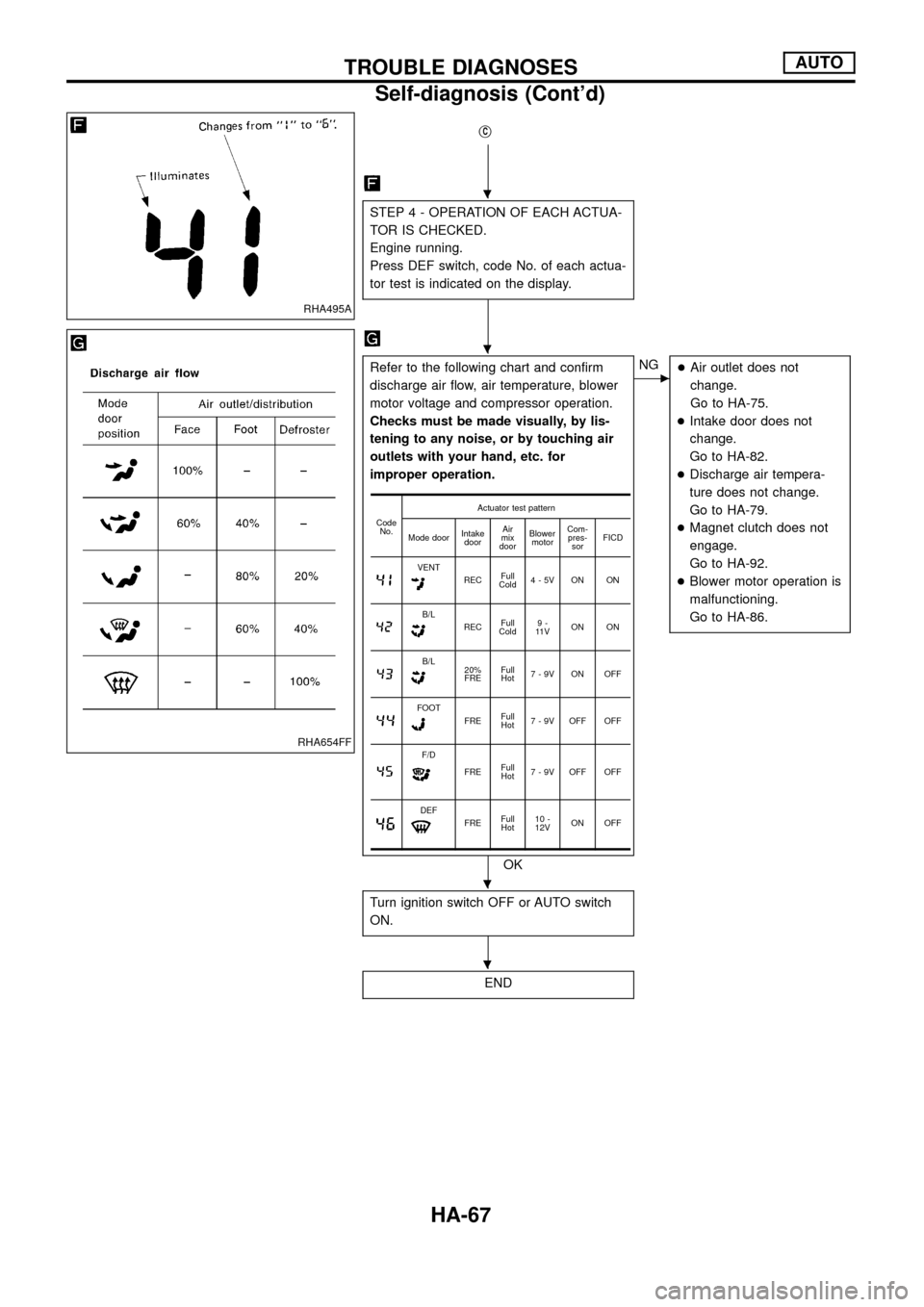Page 11 of 128

Precautions for Service Equipment
RECOVERY/RECYCLING EQUIPMENT
Follow the manufacturer's instructions for machine operation and
machine maintenance. Never introduce any refrigerant other than
that speci®ed into the machine.
ELECTRONIC LEAK DETECTOR
Follow the manufacture's instructions for tester operation and tester
maintenance.
VACUUM PUMP
The lubricant contained inside the vacuum pump is not compatible
with the speci®ed lubricant for HFC-134a (R-134a) A/C systems.
The vent side of the vacuum pump is exposed to atmospheric
pressure. So the vacuum pump lubricant may migrate out of the
pump into the service hose. This is possible when the pump is
switched off after evacuation (vacuuming) and hose is connected
to it.
To prevent this migration, use a manual valve situated near the
hose-to-pump connection, as follows.
+Usually vacuum pumps have a manual isolator valve as part of
the pump. Close this valve to isolate the service hose from the
pump.
+For pumps without an isolator, use a hose equipped with a
manual shut-off valve near the pump end. Close the valve to
isolate the hose from the pump.
+If the hose has an automatic shut off valve, disconnect the hose
from the pump: as long as the hose is connected, the valve is
open and lubricating oil may migrate.
Some one-way valves open when vacuum is applied and close
under a no vacuum condition. Such valves may restrict the pump's
ability to pull a deep vacuum and are not recommended.
MANIFOLD GAUGE SET
Be certain that the gauge face indicates R-134a or 134a. Make
sure the gauge set has 1/2²-16 ACME threaded connections for
service hoses. Con®rm the set has been used only with refrigerant
HFC-134a (R-134a) along with speci®ed lubricant.
SERVICE HOSES
Be certain that the service hoses display the markings described
(colored hose with black stripe). All hoses must include positive
shut off devices (either manual or automatic) near the end of the
hoses opposite the manifold gauge.
RHA270D
SHA533D
RHA272D
PRECAUTIONS AND PREPARATIONMANUAL AND AUTO
HA-9
Page 55 of 128

Control Operation
Display screen
Displays the operational status of the system.
AUTO switch
The compressor, intake doors, air mix door, outlet doors, and blower speed are automatically controlled so
that the in-vehicle temperature will reach, and be maintained at the set temperature selected by the operator.
Temperature dial (Potentio Temperature Control)
Increases or decreases the set temperature.
OFF switch
The compressor and blower are OFF, the intake doors are set to the outside air position, and the air outlet
doors are set to the foot (80% foot and 20% defrost) position.
FAN switch
Manual control of the blower speed. Four speeds are available for manual control (as shown on the display
screen):
low
, medium low, medium high, high
RECIRCULATION switch
OFF position: Automatic control resumes.
ON position: Interior air is recirculated inside the vehicle.
DEFROSTER switch
Positions the air outlet doors to the defrost position. Also positions the intake doors to the outside air position.
MODE switch
Control the air discharge outlets.
RHA727G
DESCRIPTIONAUTO
HA-53
Page 68 of 128
jB
STEP 3 - MODE DOOR POSITIONS
ARE CHECKED.
Does code No.
appear on the dis-
play?
Ye sNo
.
Turn temperature
dial clockwise.Mode door motor position switch is malfunctioning.
(If two or more mode doors are out of order, corre-
sponding code numbers blink respectively two
times.)
*1: If mode door motor harness connector is
disconnected, the following display pattern will
appear.
®
®®®®þ
jC
(Go to next page.)
Code
No.*1Mode door positionReference
page
VENT
HA-75
B/L
FOOT
F/D
DEF
RHA869DC
RHA168DA
RHA498A
.
.
.
TROUBLE DIAGNOSESAUTO
Self-diagnosis (Cont'd)
HA-66
Page 69 of 128

jC
STEP 4 - OPERATION OF EACH ACTUA-
TOR IS CHECKED.
Engine running.
Press DEF switch, code No. of each actua-
tor test is indicated on the display.
Refer to the following chart and con®rm
discharge air ¯ow, air temperature, blower
motor voltage and compressor operation.
Checks must be made visually, by lis-
tening to any noise, or by touching air
outlets with your hand, etc. for
improper operation.
OK
cNG
+Air outlet does not
change.
Go to HA-75.
+Intake door does not
change.
Go to HA-82.
+Discharge air tempera-
ture does not change.
Go to HA-79.
+Magnet clutch does not
engage.
Go to HA-92.
+Blower motor operation is
malfunctioning.
Go to HA-86.
Turn ignition switch OFF or AUTO switch
ON.
END
Code
No.Actuator test pattern
Mode doorIntake
doorAir
mix
doorBlower
motorCom-
pres-
sorFICD
VENTRECFull
Cold4-5V ON ON
B/LRECFull
Cold9-
11 VON ON
B/L20%
FREFull
Hot7-9V ON OFF
FOOTFREFull
Hot7 - 9V OFF OFF
F/D
FREFull
Hot7 - 9V OFF OFF
DEFFREFull
Hot10 -
12VON OFF
RHA495A
RHA654FF
.
.
.
.
TROUBLE DIAGNOSESAUTO
Self-diagnosis (Cont'd)
HA-67
Page 70 of 128
AUXILIARY MECHANISM: Temperature setting trimmer
The trimmer compensates for differences in range of 3ÉC between
temperature setting (displayed digitally) and temperature felt by
driver.
Operating procedures for this trimmer are as follows:
+Begin Self-diagnosis STEP 4 mode.
+Press
(fan) switch to set system in auxiliary mode.
+Turn temperature dial clockwise or counterclockwise as
desired. Temperature will change at a rate of 1ÉC each time a
switch is pressed.
When battery cable is disconnected, trimmer operation is can-
celed. Temperature set becomes that of initial condition, i.e.
0ÉC.
RHA581G
TROUBLE DIAGNOSESAUTO
Self-diagnosis (Cont'd)
HA-68
Page 73 of 128
b. Con®rm that discharge air comes out according to the air dis-
tribution table at left.
Refer to ``Discharge Air Flow'' (HA-13).
NOTE:
Con®rm that the compressor clutch is engaged (visualinspec-
tion) and intake door position is at FRESH when the DEF
is selected.
Intake door position is checked in the next step.
4. Check recirculation
a. Press RECswitch.
Recirculation indicator should illuminate.
b. Listen for intake door position change (you should hear blower
sound change slightly).
5. Check temperature dial
a. Turn temperature dial counterclockwise until 18ÉC is displayed.
b. Check for cold air at discharge air outlets.
c. Turn temperature dial clockwise until 32ÉC is displayed.
d. Check for hot air at discharge air outlets.
RHA654FD
RHA521G
RHA522G
TROUBLE DIAGNOSESAUTO
Operational Check (Cont'd)
HA-71
Page 74 of 128
6. Check AUTO mode
a. Press AUTO switch.
b. Display should indicate AUTO.
Con®rm that the compressor clutch engages (audio or visual
inspection).
(Discharge air and blower speed will depend on ambient,
in-vehicle, and set temperatures.)
7. Check FRESH switch
a. Press FRE switch.
FRESH indicator should illuminate.
b. Listen for intake door position change. (You should hear a slight
change in blower sound.)
8. Check A/C switch
a. Press A/C switch.
A/C indicator should illuminate.
b. Con®rm that the compressor clutch is engaged.
RHA523G
RHA524G
RHA525G
TROUBLE DIAGNOSESAUTO
Operational Check (Cont'd)
HA-72
Page 75 of 128

A/C System
TROUBLE DIAGNOSIS PROCEDURE FOR A/C SYSTEM
SYMPTOM:
+A/C system does not come on.
Inspection ¯ow
*1: HA-74 *2: HA-70
COMPONENT DESCRIPTION
Automatic ampli®er (Auto amp.)
The auto ampli®er has a built-in microcomputer which processes
information sent from various sensors needed for air conditioner
operation. The air mix door motor, mode door motor, intake door
motor, blower motor and compressor are then controlled.
The auto ampli®er is unitized with control mechanisms. Signals
from various switches and Potentio Temperature Control (PTC) are
directly entered into auto ampli®er.
Self-diagnostic functions are also built into auto ampli®er to provide
quick check of malfunctions in the auto air conditioner system.
Potentio temperature control (PTC)
The PTC is built into the A/C auto amp. It can be set at an interval
of 1ÉC in the 18ÉC to 32ÉC temperature range by turning the tem-
perature dial. The set temperature is digitally displayed.
SHA019F
RHA629G
RHA746G
TROUBLE DIAGNOSESAUTO
HA-73